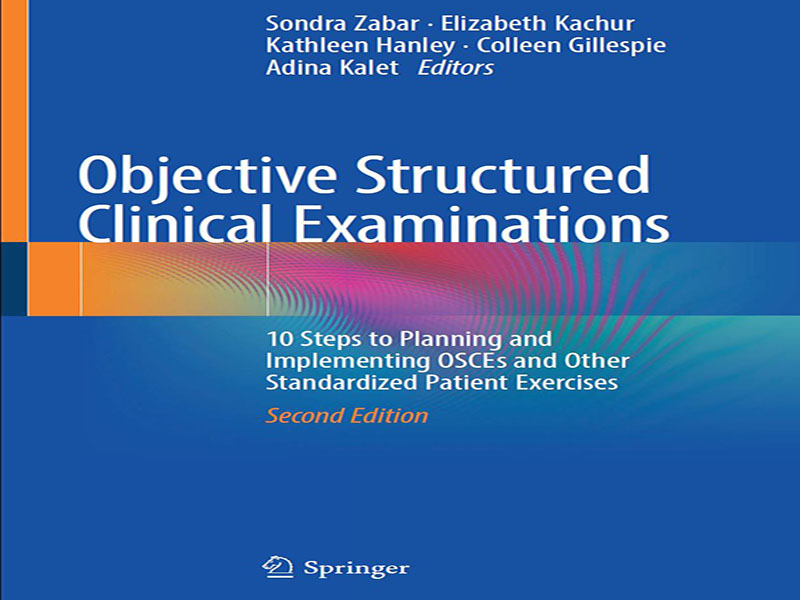- عنوان کتاب: Objective Structured Clinical Examinations
- نویسنده: Sondra Zabar, Elizabeth Kachur, Kathleen Hanley
- حوزه: معاینات بالینی
- سال انتشار: 2025
- تعداد صفحه: 245
- زبان اصلی: انگلیسی
- نوع فایل: pdf
- حجم فایل: 10.7 مگابایت
ویرایش دوم کتاب OSCE یک راهنمای عملی برای راهنمایی و پشتیبانی از مربیان حرفههای سلامت است که مایل به ایجاد یا بهبود یک برنامه ارزیابی عملکرد پیشرفته برای کارآموزان یا اساتید هستند. این ویرایش از چندین جهت کلیدی بر ویرایش اول بنا شده است. اول، روشهای جدیدی – آزمونهای بالینی ساختاریافته عینی مجازی (OSCE) و OSCEهای گروهی، و همچنین کاربردهای جدید – OSCE برای تدریس، انتقال به حرفههای سلامت و پزشکی از راه دور – را معرفی میکند. دوم، بر دانش زیربنایی، پشتیبانی و اجرای روشها، به ویژه استفاده از یادداشتها برای ارزیابی استدلال بالینی و انواع “موارد استفاده” ارزیابی مبتنی بر عملکرد عملی در آموزش حرفههای سلامت تأکید میکند. در نهایت، ما تلاش میکنیم تا پیچیدگی بیشتری را برای سازماندهی، تجسم و گزارش دادههای حاصل از این تجربیات ارائه دهیم تا یادگیری را برای افراد، برنامهها و مؤسسات بهینه کنیم. هدف ما ارائه کتابی بسیار کاربردی است که توصیههای تخصصی و مطالب ملموس و باارزشی را ارائه میدهد که میتوان آنها را به همان صورت یا متناسب با نیازهای محلی استفاده کرد. از زمان اولین ویرایش در سال ۲۰۱۳، دانشکدههای پزشکی بیشماری تصمیم گرفتهاند سرمایهگذاری جدی در تلاش، زمان و منابع مورد نیاز برای انجام خوب ارزیابی عملکرد را انجام دهند. آنها شایستگیهایی را برای اندازهگیری انتخاب کردهاند، پروندهها را نوشته و آزمایش کردهاند، بیماران/شرکتکنندگان استاندارد (SP) را استخدام و آموزش دادهاند، استانداردها را تدوین کردهاند و انبوهی از دانشجویان را چندین بار در سال در دورههای چرخشی ۱۵ دقیقهای بیشماری قرار دادهاند. چرا؟ به دلیل پذیرش روزافزون این که دانش بالینی، که میتواند به طور قابل اعتماد و معتبر از طریق امتحانات چند گزینهای آزمایش شود، مستقیماً به مهارت بالینی تبدیل نمیشود. زیرا پس از جذب دانش جدید، دانشجوی حرفههای سلامت باید یاد بگیرد که آموختههای شناختی خود را در برخوردهای انسانی همراه با مهارتهای ارتباطی، حرفهایگری، رفتار اخلاقی، استدلال بالینی و معاینه فیزیکی ادغام و به کار گیرد. برای سنجش این رفتارهای پیچیده و سطح بالا، به معاینات بالینی ساختاریافته عینی (OSCE) برای شبیهسازی – از نظر جسمی و عاطفی – برخوردهای واقعی متخصص سلامت و بیمار نیاز است. این کتاب از جزوهای برای کارگاهی در نشست سالانه انجمن مدیران برنامه در پزشکی داخلی در مورد توسعه برنامههای SP پدید آمده است. شرکتکنندگان پیشنهادهای مفیدی برای گسترش این کتاب ارائه دادند و انتشار آن را تشویق کردند. ویرایش اول، یک راهنمای عملی جامع برای توسعه تمرینهای SP در آموزش پزشکان بود. در آن توضیح داده شده بود که چگونه میتوان موارد OSCE را طراحی کرد، چگونه SPها را استخدام و آموزش داد، تدارکات را مدیریت کرد و تمام کارهای اساسی را که باعث میشود یک برنامه SP موفق یا ناموفق باشد، انجام داد. در آن زمان، این کتاب شکافی چنان گسترده در سطح جهانی را پر کرد که به زبان چینی ترجمه شد. ویراستاران و نویسندگان این کتاب، شرکای ما هستند که برنامه رزیدنتی مراقبتهای اولیه NYU/Bellevue را ایجاد و رهبری میکنند. آنها به دلیل تجربه گسترده، فداکاری و بورسیه پیشگامانه خود در آموزش پزشکی، در موقعیت خوبی برای ایجاد این راهنما قرار دارند. ما که از اواخر دهه 1980 کار خود را به صورت کوچک آغاز کردیم، در دوره دکترای خود برای دانشجویان پزشکی و در برنامه رزیدنتی پزشکی داخلی مراقبتهای اولیه، با SPها آزمایش کردیم. تا سال 2000، ما شروع به استفاده از SPها برای تجربیات آموزشی سازنده و پایانی در مقیاس وسیع و در طیف وسیعی از سطوح آموزشی و حوزههای محتوایی از جمله طب سالمندان، سلامت زنان و مهاجران و طب اعتیاد کردیم. ما در ایجاد آزمونهای OSCE با کیفیت تحقیقاتی برای ارزیابی آموزش مهارتهای ارتباطی در پروژه چند نهادی Macy Initiative in Health Communication (دانشجویان پزشکی) و سپس در یک پروژه آمادگی در برابر بلایا در مورد جنبههای روانی-اجتماعی بیوتروریسم که به طور مشترک توسط مراکز کنترل بیماریها و انجمن کالجهای پزشکی آمریکا (پزشکان، پرستاران و دستیاران پزشک) تأمین مالی شده بود، تجربه کسب کردیم. ما ارزیابیهای مهارتهای بالینی دانشجویان پزشکی را در پایه، پایان سال کارآموزی و نزدیک به فارغالتحصیلی به صورت رایگان توسعه دادیم تا بتوانیم درک کنیم که چگونه مهارتهای بالینی در ارائه دهندگان مراقبتهای بهداشتی تازه کار پیشرفت میکند. برای انجام این کار، ما متعهد به استفاده از یک چارچوب اندازهگیری واحد برای هر ارزیابی صرف نظر از مرحله شدیم. و متعهد به نظارت بر پیشرفت به صورت طولی از آموزش پزشکی کارشناسی تا تحصیلات تکمیلی شدیم. در اواسط دهه 2000، ما شروع به آزمایش استفاده از SP های اعلام نشده در برنامه رزیدنتی خود کردیم تا بفهمیم چگونه آنچه را که در OSCE اندازهگیری میکنیم به محیط عملی واقعی تبدیل میشود و ما را قادر میسازد تا کارآموزان خود را از محیط شبیهسازی شده به محیط بالینی “واقعی” دنبال کنیم. در حال حاضر، دانشجویان پزشکی ما در طول دوره پزشکی با بیش از ۴۰ مورد SP مواجه میشوند و رزیدنتهای مراقبتهای اولیه ما حدود ۴۵ مورد را در ۳ سال آموزش تکمیل میکنند. این مواجههها از تمرینهای تکوینی که صرفاً برای یادگیری طراحی شدهاند، که شامل بازخورد فوری و گزارشگیری گسترده است، تا امتحانات نهایی و حساس – به طور فزایندهای در محیط بالینی واقعی – را شامل میشود. هر مورد یا مجموعهای از موارد، ابعاد مختلفی را میآزماید (مثلاً آمادگی، ارتباطات)…
The OSCE Book second edition is a practical manual to guide and support health professions educators wishing to build or improve a state-of-the-art performance assessment program for trainees or faculty. This edition builds on the first in several key ways. First, it introduces new methods—virtual Objective Structured Clinical Examinations (OSCEs) and group OSCEs, as well as new applications—OSCEs for teaching, health professions transitions, and telemedicine. Second, it highlights the scholarship underlying, supporting, and implementing the methods, in particular, the use of notes to assess clinical reasoning and the variety of pragmatic performancebased assessment “use-cases” across health professions education. Finally, we attempt to provide enhanced sophistication to organizing, visualizing, and reporting the data from these experiences to optimize learning for individuals, programs, and institutions. We aim to provide a very pragmatic book that offers hard-earned, expert advice and concrete material, which can be used as is or tailored to local needs. Since the first edition in 2013, myriad medical schools have chosen to undertake the serious investment of effort, time, and resources needed to do performance assessment well. They have chosen competencies to measure, written and piloted cases, recruited and trained standardized patients/participants (SPs), developed standards, and scheduled hordes of students into countless 15-min rotation slots many times a year. Why? Because of the growing acceptance that clinical knowledge, which can be reliably and validly tested through multiple-choice exams, does not translate directly into clinical skill. Because after assimilating new knowledge, the health professions student must learn to integrate and apply their cognitive learnings in human encounters together with communication, professionalism, ethical behavior, clinical reasoning, and physical examination skills. To measure these complex, higher-order behaviors, Objective Structured Clinical Examinations (OSCEs) are needed to simulate—physically and emotionally—actual health professional–patient encounters. This book emerged from a handout for a workshop at the Association for Program Directors in Internal Medicine annual meeting on developing SP programs. Attendees suggested useful expansions and encouraged publication. The first edition was a comprehensive practical guide to developing SP exercises in physician training. It explained how to design OSCE cases, how to recruit and train SPs, manage logistics, and do all the nitty-gritty things that make an SP program sing or stumble. At the time, this book filled a gap so wide globally that it was translated into Chinese. The editors and authors of this book are our partners who build and lead the NYU/ Bellevue Primary Care Residency Program. They are well positioned to create this manual because of their extensive experience, dedication, and pioneering scholarship in medical education. Starting small in the late 1980s, we experimented with SP encounters in our doctoring course for medical students and in the Primary Care Internal Medicine Residency Program. By 2000, we had begun to use SPs for formative and summative educational experiences on a large scale and across a broad range of training levels and content areas including geriatrics, women’s and immigrant health, and addiction medicine. We gained experience in creating research-quality OSCEs to assess communication skills training in the multi-institutional Macy Initiative in Health Communication project (medical students) and then in a disaster preparedness project on psychosocial aspects of bioterrorism jointly funded by the Centers for Disease Control and the Association for American Medical Colleges (physicians, nurse practitioners, and physician assistants). We developed complimentary baseline, end-of-clerkship-year, and near-graduation medical student clinical encounter skills assessments to allow us to understand how clinical skills progress in novice healthcare providers. To do this, we committed to using a single measurement framework for every assessment regardless of stage; and we committed to monitoring progress longitudinally from Undergraduate to Graduate Medical Education. In the mid-2000s we began to pilot the use of unannounced SPs in our residency program in order to understand how what we measure in OSCEs translates to the real practice setting, enabling us to follow our trainees from the simulated into the “real” clinical setting. Currently, our medical students encounter upwards of 40 SP cases during medical school and our primary care residents complete around 45 cases in 3 years of training. These encounters range from formative exercises designed purely for learning, which include immediate feedback and extensive debriefing, to summative, high-stakes exams—increasingly, in the actual clinical setting. Each case or set of cases tests multiple dimensions (e.g., preparation, communication, clinical reasoning, time management, preventive medicine, error prevention, and management) of good doctoring and approaches the complexity of caring for real patients and the stresses of actual clinical practice in a controlled, reproducible, and measurable setting. After some initial resistance to the idea of OSCEs, our students and residents early on expressed their appreciation for the opportunity to practice difficult tasks in a safe environment. Now, although students still get nervous in anticipation, our OSCEs are popular and perceived as valuable teaching tools. Our residents, by and large, rate them highly, feeling they are an efficient use of time and excellent learning experiences. Faculty who participate in OSCEs—developing cases, observing, giving feedback and debriefing—report benefitting greatly from the opportunity to directly observe and calibrate their expectations and understanding of trainees. Clinical leadership appreciates that we are rigorously addressing important issues such as communication, patient safety, and patient activation. And the many SPs working closely with us in this endeavor feel that they are engaged in meaningful work, both personally and professionally. In the Primary Care Internal Medicine Residency Program, our annual all-program OSCE, initiated in 2000, is not only a central feature of program evaluation and resident assessment, but has also become an important community-building experience for residents, staff, and faculty. OSCEs are now used in the training of many health professionals in the United States and elsewhere. They are used to assess knowledge, skills, professionalism, ethical behavior, physical examination skills, and the ability to work with difficult patients, patients with diverse cultural backgrounds, patients on the phone conducting telehealth, and with families. They can measure simple processes (does the learner recommend stopping smoking?) and very complex ones (does the novice have the professional maturity to manage telling the non-English-speaking family member through an interpreter about an unexpected death and ask for an autopsy?). Much progress has been made in our ability to ensure that we graduate physicians capable of practicing medicine in our rapidly evolving healthcare environment. Yet, so much more awaits. New curriculum needs are emerging every year—interprofessional education, patient safety, systems-based practice, informatics, disaster medicine, telemedicine, to name a few recent additions. In the way that a crisis can predictably provide many breakthrough opportunities for innovation, the COVID-19 pandemic, which disrupted medical education and clinical practice, accelerated the need for remote or virtual simulation when medical students were temporarily barred from clinical settings because of limited personal protective equipment. Within days, we were able to conduct comprehensive simulations to confirm that our near graduates were ready for internship by having them demonstrate their capabilities with SPs who engaged with them and assessed from the safety of their own homes. In our case, the SPs were trained and calibrated already, and they easily mastered the technology. Students in a rural Midwest state were assessed by SPs in a southern state. These encounters were directly observed and debriefed in groups on a variety of virtual software platforms. In the end, students and faculty thanked us for continuing their education under dire circumstances. Having a rich and flexible SP-based OSCE program has allowed us to meet new curriculum and assessment challenges in a rigorous and exciting way. Developing and implementing an OSCE is a highly creative and scholarly activity, which requires a group of educators to do the difficult work of coming to consensus on educational priorities and setting standards for trainee performance. The process is scholarly because, when engaging in OSCE development, one confronts important unanswered questions about health professional competence and training. The OSCE is a robust method for answering many of these questions. For all these reasons, we find this work enjoyable and intellectually engaging, and we believe you will too. In this book, the authors share with you their experience, which will allow you to avoid common pitfalls and get directly to the fun and meaningful stuff. Call us, come visit, come see OSCEs in action, and organize a workshop. We stand ready to help.
این کتاب را میتوانید از لینک زیر بصورت رایگان دانلود کنید:




































نظرات کاربران